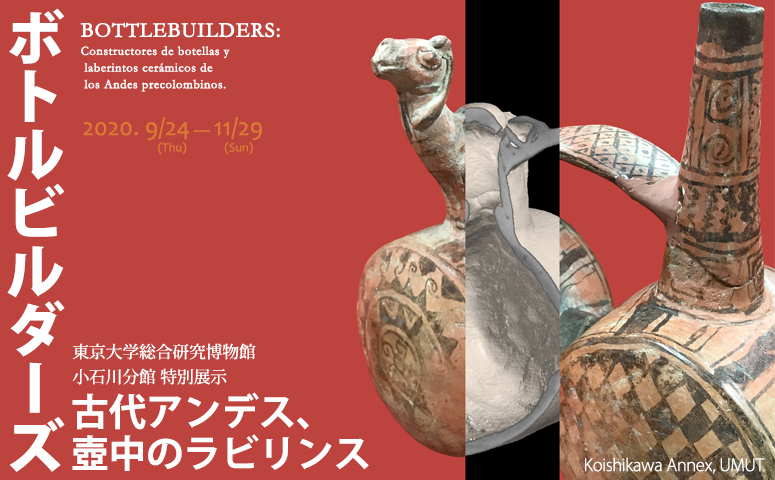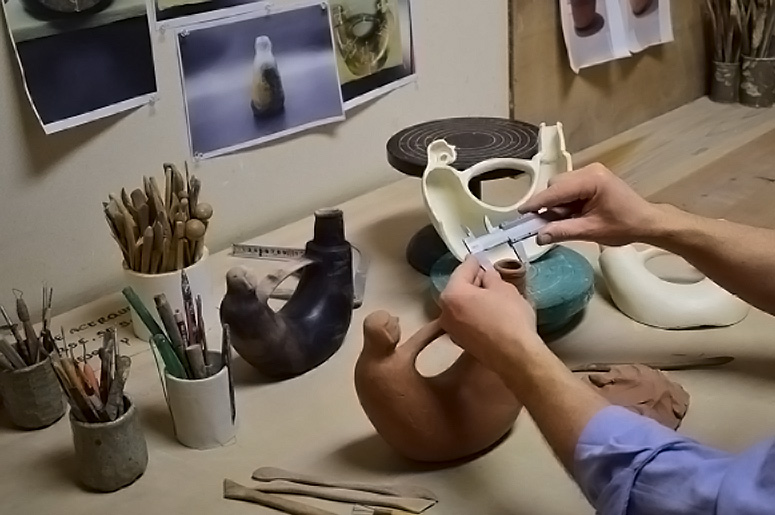

<English>
Welcome to the Labyrinth
Andean Civilization is well known for highly elaborated ceramic products. Especially, the wide variety of bottle shaped vessels are characteristic in comparison with other ancient civilizations. The shape of the bottle with narrow spout, raises questions about its manufacturing process. How could the manufacturers’ fingers and tools get in and out of the chamber? “Whistling bottle” have a built-in globular whistle. The space inside the bottle enable the liquid and the air to flow pressing on each other and to create air pressure which makes the whistle to sound. The shape of these bottles of the ancient Andes should not be considered static but needs to be reconsidered from dynamic views. Human body parts such as fingers and production tools get in and out in the process of its fabrication while liquid and air interact in each other when it is used as musical instruments. In this exhibition, we will explore the wonder of the whistling bottles by using recent technology such as X-ray CT, SfM (Structure from Motion) and experimental replication.
Eisei Tsurumi (
Ressearch Associate, The University Museum, The University of Tokyo / Andean Archaeology, Cultural Anthropology)
<Español>
Bienvenidos al laberinto
La civilización Andina es conocida por su excelencia en la alfarería, distinguiéndose entre las civilizaciones antiguas por la riqueza y variedad de sus botellas. El restringido gollete de las botellas arroja la pregunta, cómo las herramientas y/o dedos del alfarero pudieron introducirse para su creación. Existen botellas silbadoras de complejo funcionamiento, en su interior cuentan con un silbato globular que suena al recibir aire proveniente de la presión ejercida de un líquido en movimiento. Las botellas Andinas ancestrales deben ser consideradas no solo desde un punto de vista estático, es necesario considerar su dinámica, el movimiento del líquido y aire, herramientas y cuerpo. En esta exhibición, enfocamos la maravilla de las botellas silbadoras utilizando métodos especializados como TC, SfM (Structure from Motion) y replicación experimental.
Eisei Tsurumi (
Profesor asistente, Museo Universitario de la Universidad de Tokio / arqueología andina, antropología cultural)
Special Exhibition "BOTTLEBUILDERS: Constructores de botellas y laberintos cerámicos de los Andes precolombinos"
(Exhibición especial "BOTTELBUILDERS: Constructores de botellas y laberintos cerámicos de los Andes precolombinos")
Period: Saturday, September 24, 2020 to Sunday, November 29, 2020
Institution: The Koishikawa Annex, The University Museum, The University of Tokyo / Museum of Architecture
Location: 3-7-1 Hakusan Bunkyo-ku, Tokyo, Japan Access
Opening Hours: 10:00-16:30 (last admission at 16:00)
Closed Days: Closed on Mondays, Tuesdays, Wednesdays (open on national holidays). May closed irregularly.
Admission: Free of charge
Entry procedure: An entry procedure is required before entering the museum. (No reservation is required)
Contact: +81 (0)50-5541-8600 (Hello Dial)
Host Organization: The University Museum, The University of Tokyo
Cohost Organizations: BIZEN Latin America Museum, Okayama Prefectural University, Research Institute of Civilization and Micro/Nano Technology Center of Tokai University
Collaborating Organizations: Komaba Museum of the University of Tokyo, Grant-in-Aid for Scientific Research on Innovative Areas “Integrative Human Historical Science of ‘Out of Eurasia’ Exploring the Mechanisms of the Development of Civilization”
ARCHITECTONICA Seminar
Date: Saturday, November 14, 2020
Venue: The Koishikawa Annex, The University Museum, The University of Tokyo / Museum of Architecture
Guide: Mau Macedo (Okayama Prefectural University)
Details of the event to be announced later.
Exhibition flyer (PDF, Japanese)
Exhibition Planners and Collaborators
Ā(Planificadores de exhibicioüLn y colaboradores)
Academic and Design Planning: Eisei Tsurumi (Research Associate, The University Museum, The University of Tokyo )
Gallery Layout Planning: Fumio Matsumoto (Project Professor, The University Museum, The University of Tokyo)
Koishikawa Annex: Akihiko Nagai (Project Researcher, The University Museum, The University of Tokyo)
Research on collections and experimental replication: Mau Macedo (Okayama Prefectural University)
Research on collections: Yasuyuki Morishita (BIZEN Latin America Museum), Kyoko Yamahana (Tokai University)
X-ray CT Imaging and processing: Yu Maekawa, Tomohiko Sasaki (Kyoto University)
3D Modeling by SfM: Hisashi Nakao (Nanzan University), Akihiro Kaneda (Nara Nara National Research Institute for Cultural Properties), Kohei Tamura (Tohoku University), Koji Noshita (Kyushu University)
Corporation in filming: Takeshi Kamei

Toppage of Koishikawa Annex, the University Museum, the University of Tokyo